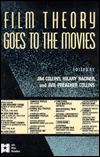|
Film Theory Goes to the Movies
Edited by Jim Collins & Hillary Radner
|
 |
Spectacles of Death: Identification,
Reflexivity, and Contemporary Horror
by Jeffrey Sconce
. . .A columnist in Premiere magazine reports overhearing the
following conversation in a video store. Two teenage girls argue over which movie monster
they would prefer to be killed by, Jason of Friday the 13th, Michael of Halloween,
or Freddy of Nightmare on Elm Street. One girl makes the case against Freddy:
"Jason or that Halloween guy, they just kill you and you're dead. That's
all you have to worry about. Freddy makes you a nervous wreck and then kills you and
then turns you into a face sticking out of his chest!"
"Yeah, but he's so funny."
"Only because you're watching the movie! If you were in the movie and he was chasing you,
you wouldn't be thinking, like, 'What a funny guy!' You'd be screaming and yelling and trying
to get away, just like the kids in the movie!"
At this point, the Premiere writer interjects himself in the conversation to ask
about Norman Bates. "Who?" the girl asks. "The guy from the Psycho movies." "Oh him. He stinks,"
offers one girl. "He's just an old guy."
. . .This anecdote of horror's generation gap typifies the low critical
esteem most film commentators have for the contemporary horror film, especially the subgenre of the
"slasher" movie. Despite their commercial success and stylistic variety, such films remain a
target of indiscriminate ridicule by the film connoisseur. Often, this derision is aimed as well at
the teenage target audience for these films, which critics routinely characterize as a legion of
brain-dead pubescent zombies docilely filing into the nation's multiplexes for each new "teenie-kill"
release.
. . .As a convenient doormat of popular film criticism, "slasher" movies
provide a formulaic reference point for critics to compare other, more "worthy" horror films. Consider,
for example, a Rolling Stone review for the art-house horror success, Henry: Portrait of a
Serial Killer (1987). Speaking of the slasher cycles of the 1980s, this critic writes, "Those
films offer supernatural villains and cardboard victims; they're easy to shake. Not so Henry.
The film is no masterpiece, but it is spare, intelligent, and thought-provoking." By comparison, the
Nightmare on Elm Street films would no doubt be labeled loud, stupid, and mind-numbing. . .(p. 103)
. . .Freddy and Henry are both brutal and relentless agents of death. As celebrity serial killers, each
stars in a "body-count" film, a movie that structures its narrative progression around a series of
increasingly gruesome murders. What distinguishes the films and their subsequent critical reputations
is the cultural context of their release and circulation as well as the actual style of their
"execution.". . . Appearing in the wake of John Carpenter's Halloween and Sean Cunningham's
Friday the 13th, A Nightmare On Elm Street and subsequent series were quickly relegated
to the "slasher" ghetto. By and large, the Nightmare series came to be seen as a highly
formulaic and thus uninteresting group of films, thin on plot and heavy on special effects, pumped
out at regular year-and-a-half intervals for a teen audience that didn't expect much in the
first place. . . (p. 105)

|